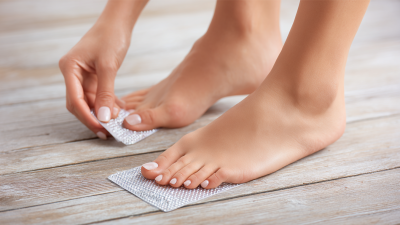As winter approaches, maintaining warmth and comfort becomes essential, particularly for our feet, which are often overlooked in temperature management. The market for heating solutions has shown remarkable growth, with a recent report by Grand View Research indicating that the global foot warmer market is projected to reach $1.8 billion by 2025, driven by increasing awareness of thermal comfort and health benefits associated with proper foot warmth.

Foot warmers, including electric heat pads, heated insoles, and infrared devices, have surged in popularity as consumers seek effective ways to combat the chill. Not only do these innovative products provide immediate relief from cold, but they also contribute to improved circulation and overall well-being. This ultimate guide aims to explore the best foot warmers available, ensuring you stay cozy during the coldest months of the year.
When choosing the right type of foot warmer for your needs, it's essential to consider your specific preferences and lifestyle. Various types of foot warmers are available, ranging from electric heated blankets to infrared foot baths. Electric models often provide quick heat and adjustable settings for personalized comfort, making them ideal for those who need immediate relief from the cold. On the other hand, non-electric options, such as heated socks or microwaveable foot warmers, can be more portable and convenient for people who travel frequently or prefer a more eco-friendly solution.
Aside from the type of warming method, you should also evaluate the size and design of the product. Some foot warmers are designed to accommodate only your feet, while others may offer larger spaces for sitting or lounging comfortably. The materials used, such as plush fabrics or innovative thermal insulation, can significantly affect comfort and warmth retention. Ultimately, finding the best foot warmer for your winter relaxation involves balancing efficiency, comfort, and personal style to ensure you stay cozy throughout the colder months.
| Type of Foot Warmer | Heat Settings | Size | Material | Power Source | Average Price ($) |
|---|---|---|---|---|---|
| Electric Booties | 3 Settings | One Size Fits Most | Fleece | Electric | 50 |
| Heating Pads | Multiple Settings | Various Sizes | Cotton | Electric | 30 |
| Foot Warmers Inserts | None | Customizable | Thermal Fabric | Gel Pack | 15 |
| Heated Socks | 2 Settings | Standard | Wool Blend | Rechargeable Battery | 40 |
| Portable Foot Warmer | Single Setting | Compact | Plastic | Electric | 25 |
As the winter months approach, keeping your feet warm becomes a priority for many. When considering foot warmers, it’s essential to explore the different heating methods available, each offering unique benefits. Electric foot warmers, for instance, have gained popularity due to their efficiency and convenience. According to a recent report by Statista, the global electric heating market is expected to reach USD 65.3 billion by 2027, reflecting a growing consumer preference for electric solutions in home comfort. These warmers can typically heat up quickly and provide adjustable temperature settings, allowing users to find their perfect level of coziness.
Microwaveable foot warmers, on the other hand, provide an alternative that doesn’t rely on electricity. These products often use natural materials such as rice or flaxseed, which can retain heat for an extended period. According to a study published in the Journal of Thermal Biology, microwaveable heat packs can provide pain relief and warmth, benefiting people with cold feet or circulatory issues. This method is especially appealing for those looking for a portable and energy-efficient option, as they require only a few minutes in the microwave to deliver soothing warmth. By exploring various heating methods, individuals can select the best foot warmer tailored to their lifestyle preferences.
This chart compares different heating methods for foot warmers based on user ratings and average heating time.
When selecting a high-quality foot warmer, several key features should be prioritized to ensure optimal comfort and efficiency. Firstly, look for an adjustable temperature setting. A report from the Home Appliance Manufacturers Association (HAMA) indicates that units with multiple heat settings have a 30% higher user satisfaction rate, as they allow for personalized warmth based on individual preferences and ambient temperatures. This feature can be particularly beneficial during extremely cold weather when a flexible heating option is essential for maintaining foot comfort.
Additionally, consider the materials used in the construction of the foot warmer. High-quality units often feature soft, breathable fabrics that enhance comfort while promoting good airflow. According to the American Society of Heating, Refrigerating and Air-Conditioning Engineers (ASHRAE), products made with thermal insulating materials can save up to 20% more energy than their conventional counterparts, making them more eco-friendly and cost-effective in the long run. This emphasis on both comfort and sustainability is crucial as more consumers seek products that align with their lifestyle values while providing the warmth they need during the chilly winter months.

When using foot warmers, safety should always be a priority to ensure a comfortable and hazard-free experience. One of the most important tips is to follow the manufacturer’s instructions carefully. This includes understanding the proper settings and duration for use, as overheating can lead to burns or damage to the device. Additionally, it’s advisable to avoid using foot warmers while sleeping, as this can increase the risk of overheating and reduce your ability to react if something goes wrong.
Another key safety measure is to regularly check the condition of your foot warmer. Look for any signs of wear and tear, such as frayed cords or damaged heating elements. If you notice any issues, it’s best to discontinue use and seek a replacement to prevent accidents. Furthermore, it’s wise to use foot warmers on a stable, heat-resistant surface to prevent any fire hazards. By taking these precautions, you can enjoy the cozy warmth of foot warmers while ensuring your safety during the chilly winter months.

When it comes to keeping your feet warm in the winter, foot warmers can be invaluable. However, to ensure longevity and optimal performance of your device, proper maintenance and cleaning are essential. According to a report by the Association of Home Appliance Manufacturers, regular upkeep can extend the lifespan of heating appliances by as much as 50%. This means that taking the time to care for your foot warmer not only enhances its efficiency but also saves money in the long run.
To maintain your foot warmer, it is crucial to follow the manufacturer's cleaning guidelines. Most models recommend unplugging the unit and allowing it to cool down completely before any cleaning. A damp cloth with mild soap can effectively remove dirt, while avoiding abrasive cleansers that might damage the heating elements. Additionally, storing your foot warmer in a dry, dust-free environment helps prevent any buildup of debris, which can hinder its functionality. Data from International Energy Agency suggests that maintaining heating devices properly can also lead to increased energy efficiency, making them both eco-friendly and cost-effective during those chilly months.






